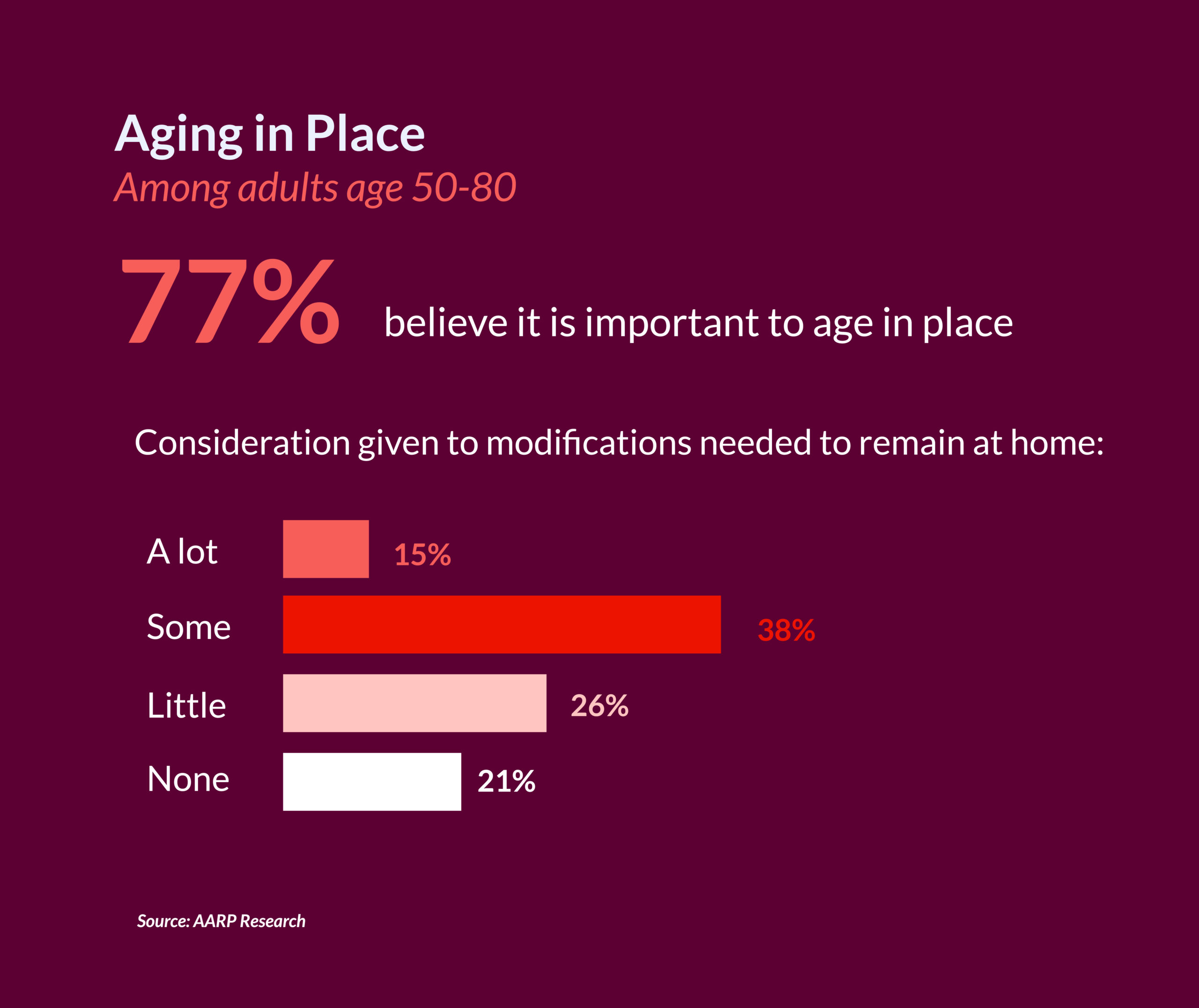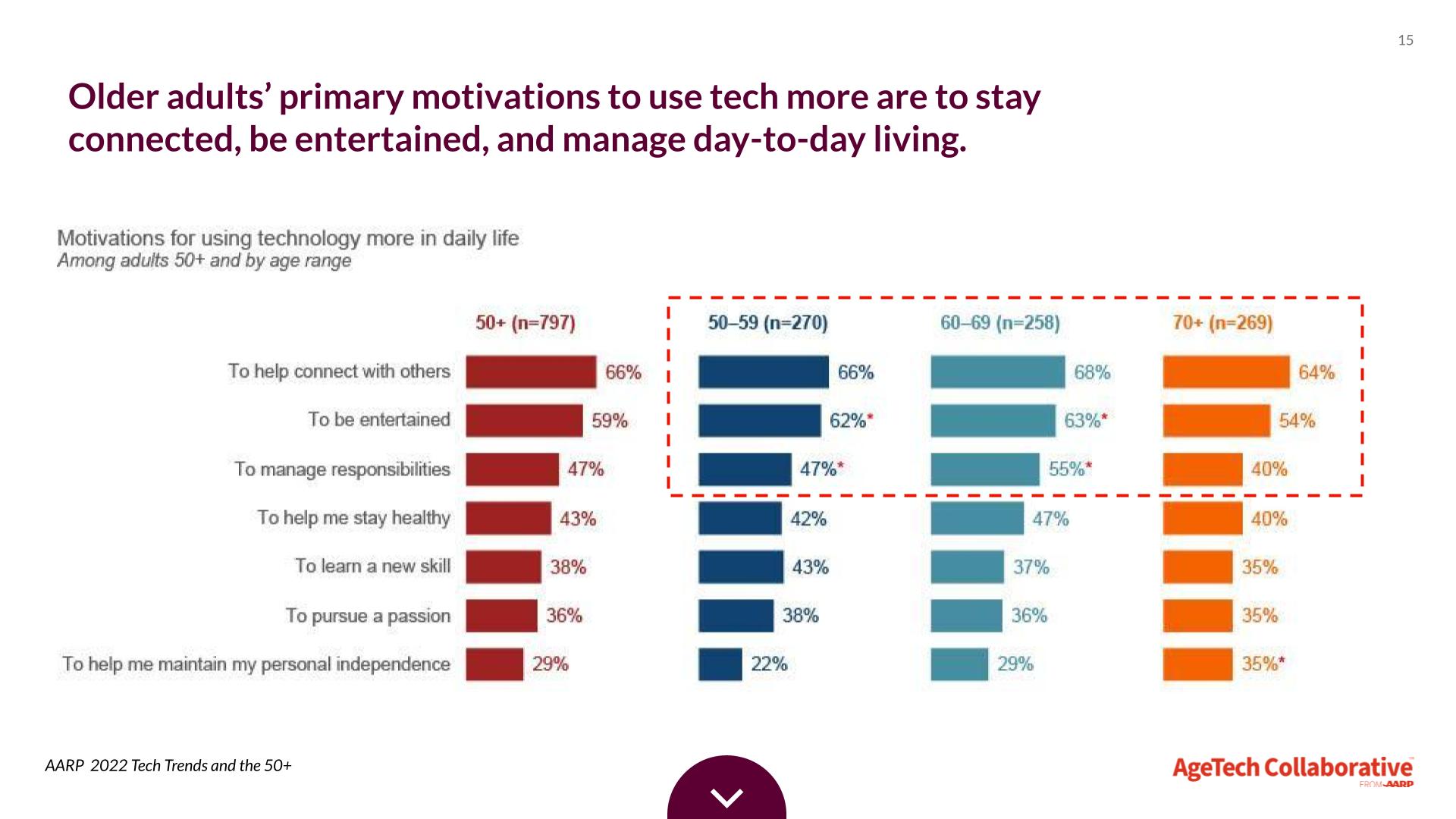Smart Home Technology for Older Adults
February 2024
About the study:
The smart home technology currently targeted toward older adults has the potential to allow them to remain in their homes, living independently for longer. While technology exists to make this happen, the challenges remain in overcoming older adults’ confidence in using technology and their concerns over privacy and security. To better understand and address these challenges, the AgeTech Collaborative initiated a study with a two-pronged approach to understand the perceptions of older adults around smart home, comprised of:
- Secondary research scan
- Qualitative research with unpaid/family caregivers* and care recipients
*Caregivers include both those who live with care recipients and those who live apart
Why do we need Smart Home Technology?

Older Adults’ Preparedness to Age in Place, AARP Copyright: Michigan Medicine, April 2022
Most homes were built when there were a small number of older adults in the population – or they were built with the younger end of the population range in mind. But by 2034, more people will be over 65 than under 18. Little of today’s housing, including 55+ communities, account for the future benefits of smart home technology or its possible use by an aging population.
A ‘Smart Home’ according to the Oxford dictionary, is “a home equipped with lighting, heating, and electronic devices that can be controlled remotely by phone or computer.”
As work, school, medical visits, fitness, and shopping all moved under one roof during the pandemic, demand for a suite of connected home devices and services exploded.
“The global smart home device market is expected to top $165B by 2025,” according to CB Insights (The Future of Home, 2022).
What are the Market Segments?
The Covid-19 pandemic continues to shape the attitude of older adults about their future, further cementing their interest in aging in place. To respond to this need there are four market segments that are most relevant to older consumers. They are communication and engagement, safety and security, heath and wellness and learning and contribution.

The Interdependency of technology for older adults Copyright: Aging in Place Technology Watch 2022
1. Communication and Engagement
Email, VR , Games, Apps, Video Cell/Smartphones, Tablets, Smart Speakers, Voice Assistants, Hearables.
For all ages, isolation is increasingly untenable without the technology to connect to others. As we move forward, tech vendors will promote a gaggle of gadgets to mitigate all barriers, emphasizing voice and ‘no-touch’ offerings over tablets.
2. Safety and Security
Security, PERS Watch, Voice Help, Cameras, Fall Detection, Home and Inactivity Monitor, Sensors, Radar
‘Aging in place’ requires a home free from obstacles and dangers, especially for the 45% of women aged 75+ who live alone. The pivotal entrance of Apple’s fall detection legitimized the market for caregiving smartwatch wearables with fall detection. Other sensor-based in-room approaches to fall detection are now in-market.
3. Health and Wellness
Health Apps, Telehealth, Medication mgmt., Disease mgmt., Fitness/Trackers, Voice Assistants, Health Wearables
The abrupt shutdown of health visits during the pandemic triggered frenetic adoption of telehealth – now firmly entrenched as a care option. Remote Patient Monitoring (RPM) is also on a growth trajectory and is even a service offered by some home care agencies.
4. Learning and Contribution
Legacy, Education and Learning, Working, Volunteering, Financial Wellness
Experts have noted that once the basic needs of communication, safety, and health are addressed, people have both the demand and capacity for more. This includes learning, staying aware and active in society, contributing through online volunteering, and training growing numbers of older workers. These independent market segments can come together to create a fulfilling and interactive life for older adults as they age in their homes.
We need to remember that the individual needs in these market segments are not stagnant and they vary over time as they age. As time passes, older adults move from a spectrum of independent to frail and so do their needs. The technological focus changes from a category like home safety to personal safety to further move to personal medical status.

Technology needs evolve over time Copyright: Aging in Place Technology Watch 2022
What are the interests and motivations of the Older Adults?
According to a 2022 study by AARP, learning how to manage smart home tech, stream entertainment and video chat interest the 50 plus the most.

Source: AARP 2022 Tech Trends and the 50+
According to the same study, the primary motivations for older adults to use tech more are to stay connected, be entertained and to manage day-to-day living. Social isolation can prove to be detrimental, and hence socializing using technology is a key need for older adults.

Source: AARP 2022 Tech Trends and the 50+
What are the perceptions around Smart Home technology?
Through our focus group research we explored the different perceptions and opinions that older adults had around Smart Home technology. The participants included care recipients and caregivers. They shared what they valued and what they considered barriers in their experiences with it.
Perception of Value
- Participants Recognized Potential Value of Smart Home Tech Benefits included:
- Keeping in touch with family and friends
- Providing life-saving alerts and monitoring
- Convenience
- Greater independence for care recipients and reduced burden on caregivers
- Increased Independence & Convenience
- Care recipients recognized the potential for a greater sense of independence and reduced burden on caregivers
- Caregivers viewed smart home devices as a great convenience that had the potential to take tasks off their plate, even if care recipients weren’t able to operate the devices themselves
- Increased Safety & Security
- Participants indicated that many smart home devices (like doorbells or video conferencing) could provide comfort and a sense of security from a distance
- Health monitoring smart home devices were viewed as essential for preventing bad outcomes
- Care recipients felt that health monitoring devices had the potential to provide them with more control over their daily lives
Shared Barriers
- Usability Issues & the Fear of Not Figuring It Out
- Learning new technology can be difficult for older adults
- Failed attempts make users feel old
- Attempting to learn new things is a risk to one’s self-image
- Data Privacy Concerns
- Sharing is OK provided it benefits users or greater good
- Participants feared data being used against them (e.g. to deny insurance coverage or increase premiums)
- Both caregivers and care recipients were sensitive to the boundaries of when too much information might be shared with caregivers
- Hesitation Regarding Safety and Reliability
- Certain devices are associated with greater failure risks (e.g. health monitoring devices)
- Caregivers have high expectations for these devices to perform as there may be no second chances
- Lack of Device & Service Integration
- Participants expressed hesitation around redundant devices
- Participants also wondered how data from health management devices would be integrated into existing treatment plans.
- Greater complexity was met with skepticism
- Diminished Cognitive Ability
- Participants varied in attitudes and capabilities which could affect the appeal and ideal usage of different smart home technologies
- The older adults we spoke to expressed a strong desire to learn, but several caregivers looking after people with cognitive decline indicated learn anything can be difficult
Key Takeaways:
- As Baby Boomers continue to age in their homes, there is a growing market of smart home technology products to assist them with health, caregiving, and safety needs.
- Older adults are interested in, and motivated to use smart home technology to make aging in their homes easier.
- Stigma, privacy, ease of use, and cost are significant concerns of older adults when considering smart home technology.
According to a study by Smart Home forecast (2021), almost 50% of total US households will be smart home device households by 2025 culminating into a sizable market opportunity. It’s crucial that the needs of the 50+ demographic are considered when developing new products in this space. AgeTech Collaborative and its 500+ ecosystem participants are poised to seize this opportunity to make aging easier for everyone.
Gain access to more 50+ research, analysis, trends, and connect to key players in this rapidly growing market. Join our one-of-a-kind ecosystem of the best minds in AgeTech.
